
Honestly, we’re pretty jealous comedian Chris Hardwick managed to woo Tom Hanks into an interview for his Nerdist podcast using a vintage typewriter—mostly because we didn’t think of it first. Hardwick, a minor celebrity in his own right, learned from his talent booker, who knows Hanks’ assistant, that the actor collects typewriters.
So Hardwick purchased a 1934 Smith Corona, and typed a letter to the Oscar-winning actor imploring, “We are nice guys who are easy to get along with and have never murdered anyone.” He then had the typewriter with the letter in the carriage delivered to Hanks. Hanks responded with his own typewritten letter, feigning indignation at the bribe: “You are out of your minds if you think… that I… wow, this thing has great action… and this deep crimson color… Wait! I’m not so shallow as to… and it types nearly silently… Oh, OKAY!”

Top: Richard Polt suspects Hanks could be wooed with a rare 1950s Olivetti Graphika. Via Writing Ball. Above: Tom Hanks stood in front of his typewriter collection when he made a video endorsing President Barack Obama in 2008.
Recently, Nerdist posted its interview wherein Hardwick and his friends Jonah Ray and Matt Mira hang out with Hanks, who stars in the upcoming “Cloud Atlas,” in the offices of his Playtone production studio in Santa Monica. For more than an hour and a half, they joke and reminisce with the actor about his decades-long career. Only about five minutes of the chat is actually about typewriters.
“You know typewriters are essentially worthless,” Hanks tells Nerdist. “But I love them. And you know, I buy a lot of typewriters … usually like 50 bucks at swap meets and stuff like that.”

This 1940s Smith Corona is just like the one Tom Hanks proudly hauled all over the United States and Europe last year.
Tom Hanks loves typewriters so much, he’s posted dozens of them to Twitter and Facebook through his WhoSay account. He’s also got videos of himself plinking dramatically on a 1940s Smith Corona at the CNN headquarters, in front of Wrigley Field in Chicago, in a hotel outside the Brandenburg Gate in Berlin, in front of the Eiffel Tower in Paris, and on the Westminster Bridge in London.
“I laughed when Tom Hanks talked about how high-quality those typewriters were, because they’re junk.”
Hanks displays most of his collection—150-plus 20th-century typewriters—at his Playtone office, but according to Country Living magazine, he also keeps one by the phone at home and uses typewriters to write notes to friends.
We’d love to get nerdy with Hanks about various typewriter carriages, ribbons, and fonts, but we’d to have to do a lot better than a 1934 Smith Corona, which can be picked up for $20-$100—especially because we don’t have a well-connected talent booker. So we asked some our favorite typewriter collectors to help us figure out what machine we could best bribe Tom Hanks with.

A machine that could bribe Hanks? This extremely rare sterling silver 1930s Smith Corona is the pride of Alan Seaver’s collection. But Hanks already has one. Via Machines of Loving Grace.
“That’s a good question, because he already has most of the good ones,” says Alan Seaver, of Machines of Loving Grace. Seaver says he would go for a 1930s flattop Smith Corona, but not an ordinary black one, which were made by the hundreds of thousands. He suggests a specialized Smith Corona Sterling made with a sterling silver jacket—even though he and Hanks both own one already—as these are extraordinarily rare and valuable.
“There are the sounds, the ‘click-clack-ding!’, the action of the carriage, the smell of the ink and rubber, the shininess of the machine.”
“There are only a handful in existence,” Seaver says. “I know he bought one from a guy I know. I know of fewer than 10 in existence, and there were only 184 made to start with. It was a special one for window dealer displays when they first introduced the model in late 1930, right before the Christmas season.
“Of course, this was in the middle of the Depression,” Seaver continues. “This was an expensive display for the time, about $125 for the entire window, including the typewriter,” he says. “And the retail price was $100 just for the regular machine. So the sales team actually told dealers, ‘If you want to, swap out the body, put a regular shell on top of this machine, and take the silver jacket to have it melted down and get your money back for the display.’ So I think that’s why there are so few around—most of them were melted down.”

Typewriter collector Richard Polt thinks he could bribe Tom Hanks with his stripped down 1950s West German Voss. Via Writing Ball.
Richard Polt of The Classic Typewriter Page, would go another route, trying to impress Hanks with his stripped-down 1950s Voss, a West German-made portable, which has a blobby, abstract Mid-Century Modern vibe to it.
“I have one that I stripped all the paint off of, so it’s shiny aluminum,” Polt says. “I think that would be pretty tempting. They’re well made, but the first thing you notice about them is their shape; it’s a biomorphic, sensuous looking shape. It’s one of the best designs ever. They’re a dime a dozen in Germany, and some were imported into the U.S. In the last few years, I’ve been modifying some of the more common typewriters by painting them or stripping off the paint and seeing what effects I can get. It makes the hobby a little bit more like hot rodding.”

Ian Fleming’s Royal Gold typewriter. Via Robert Messenger’s ozTypewriter Australian Typewriter Museum at oztypewriter.blogspot.com.
Other typewriter bribes Seaver and Polt suggested include a late 1940s gold-plated Royal typewriter, like the one Ian Fleming owned; a rare 1930s Animal Key Smith Corona for children, which featured animals on the keys and came with matching finger rings; a 1970s Royal Fleetwood with a transistor radio built into it; a rare simple point-and-click 1920s typewriter from Spain known as the Hogar; the Olivetti Graphika, whose proportional typeface accomodates characters of different widths; and the Keaton Music Typewriter, which was used to create musical scores.
As much as I’m sure Hanks would love these rare machines, he seems to be an equal-opportunity typewriter lover. On the Nerdist podcast, Hanks relays the story of getting suckered by a woman who wrote him a letter and talked him into buying a $50 typewriter for $500 to help send her grandson to college.
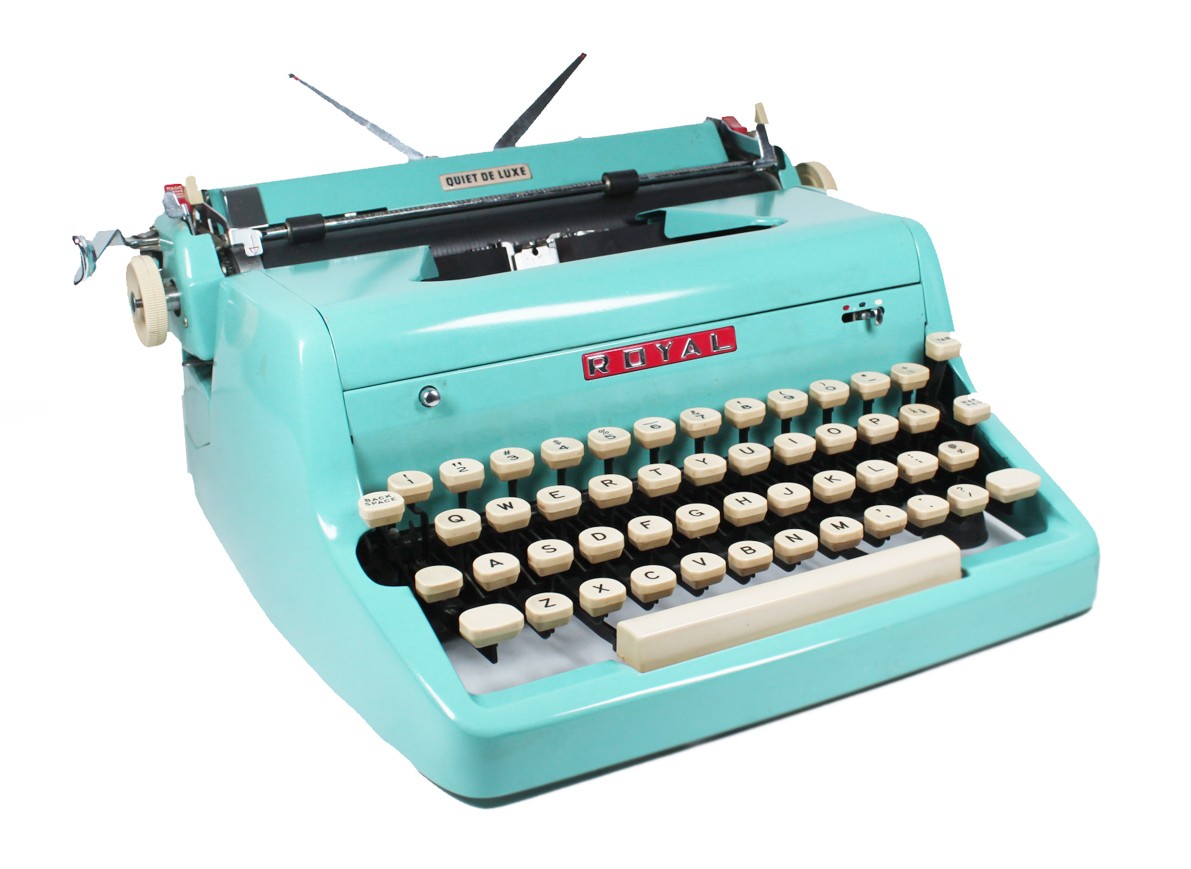
Tom Hanks posted a similar 1940s turquoise Royal Quiet De Luxe typewriter on his social media pages last year. Image via Brooklyn Retro.
But that’s the last time he’ll do that. Don’t even think of sending him your grandfather’s creaky typewriter collecting dust in your attic.
Another thing Hanks doesn’t need is another 1950s East German typewriter. After visiting a museum in Germany last year, he casually mentioned his fondness for such devices. “As it turns out, East Germany in the ’50s had a pretty good economy and they made really good typewriters,” Hanks tells the Nerdist, “which I commented on. And next thing I know, boom! It’s on the radio, and I’ve got East German typewriters arriving at the hotel. So I scored good.

This Groma Kolibri from 1950s East Germany is the sort of typewriter featured in “The Lives of Others.” From Polt’s collection, via The Classic Typewriter Page.
“And everybody got a letter back,” he continues. “The thing that’s tough about German typewriters is that in German, the Y is not used nearly as much as the letter Z, so on the keyboard they’re transposed. In English keyboards, it’s QWERTY; in Germany it’s QWERTZ. So typing a letter to someone on a German typewriter, it’s just a motherfucker.”
Seaver, however, chuckles at the thought of coveting these old Soviet-factory devices. “I have to laugh when he talks about how high-quality they were, because they’re junk,” he says. “If you compare something made in West Germany with something made in East Germany, they’re just not the same. It’s not as terrible as the modern Chinese made typewriters, but you can just tell it’s not as well-made.”

A 1910s Oliver typewriter with its peculiar U-shaped typebars, like this one in Polt’s collection, sits on a shelf in Hanks’ Playtone offices. Via The Classic Typewriter Page.
Polt disagrees that the East German typewriters were complete garbage. “The best were probably the West Germans, but the East Germans were pretty close behind. Germany had a large typewriter industry before the war. And then it did continue after the war, when the state was split into two countries. One of the coolest East German typewriters was called the Groma Kolibri, which got a lot of attention in the film ‘The Lives of Others,’ because it’s a small, flat laptop typewriter. And in the movie, it’s hidden under the floorboards and used to write subversive literature. ”
In Country Living magazine, Hanks explained that the typewriters he prefers are the, “old manual typewriters that were made prior to the Second World War. I keep them by the telephone and I use them to write notes to my friends.”

A 1900s Yost typewriter, like this one, has also been spied at Hanks’ office. Via Typewriter.be.
Seaver explains that before the war, when manual typewriters still used fabric ribbons that stamped ink onto the paper instead of carbon film, there were two distinct markets for typewriters. “You had the office machines, which were really well-made, and of course, they were designed to last, because in the ’30s, firms weren’t going to be buying a new typewriter every year. The price of one typewriter was the equivalent of thousands of dollars today. Only successful companies could afford something like that.
“Most of your portables in the ’30s are actually meh,” he continues. “They’re designed to be affordable to the average person. They’re sort of clattery. A lot of them come across as cheaply made, because the companies had to get the price down to between $20 and $60.”

Hanks has also posted a Swiss-made Hermes 3000 from the 1950s with its distinctive hospital-green keys as his “typewriter of the week.” Via Machines of Loving Grace.
But things changed after the war. “As you move into the ’50s, the quality of the portables got better, because people could afford them again,” Seaver says. “And, of course, there were mechanical improvements. But there’s just something about the design aesthetic I find lacking. Things really went downhill in the ’60s and ’70s, because you got into the whole ‘corporate mentality.’ The manufacturers started making them out of plastic, making them as cheap and light as possible. The quality suffered because they became more disposable.”
In Country Living, Hanks reiterated that he’s not likely to spend a great sum on his typewriters, usually around $45 apiece. But then, he’ll spend $125 getting the machine repaired instead of doing it himself like Polt and other collector-tinkerers are wont to do. Hanks is known to put money into acquiring cheap typewriters, too, as he is often quoted, saying, “I bought a $5 typewriter from Australia that cost me $85 to ship.”

Tom Hanks has a Royal Apollo 10 typewriter from 1969, but Seaver thinks he could be seduced by this deluxe Royal Fleetwood from 1972, featuring a built-in transistor radio. Via Machines of Loving Grace.
“A hundred dollars, of course, for him is like 10 cents,” Polt says. “For some of us, that is actual money. Still, it’s a relatively affordable hobby, and that’s one thing I like about it. If you’re not too picky as far as rarity goes, you can find lots of nice, interesting working typewriters for under $50.”
Seaver agrees that Hanks’interest in typewriters is not about high-end showpieces, which mostly come from the late 1800s and early 1900s, when inventors were coming up with wild contraptions to avoid stepping on each other’s patents.
“Tom Hanks mostly has what I would call the common machines, but they are nice to look at and nice to use,” Seaver says. “He’s a user. He collects them to use them, and he’s probably got a couple that display nicely. He’s not one of those people who spends thousands of dollars on extraordinarily rare ones that go in a glass case and only get handled with white gloves. I, too, consider myself a typewriter omnivore. I’ll grab whatever I see, and I’ll get rid of it later if I don’t like it.”

This is a 1934 flattop Smith Corona similar to the one Chris Hardwick sent Hanks. Via Machines of Loving Grace.
But do typewriter collectors take exception to Hanks’ statement that typewriters are worthless?
“To your average person, they are,” Seaver says.”They are obsolete, and there’s just a certain type of person who has an attraction to them. To most people, typewriters are paperweights. They’re just some old piece of office equipment that isn’t useful anymore.”
“Next thing I know, boom! It’s on the radio, and I’ve got East German typewriters arriving at the hotel.”
Polt, however, says he thinks Hanks was exaggerating a bit. “Your average typewriter is going to be worth very little because supply exceeds demand,” he says. “But very few of them are worthless, because increasingly there are people out there who want them. Unfortunately, some of them want them to cut off the keys and make jewelry, which horrifies collectors.”
Why, then, are these things so valuable to one of the biggest actors of our time? In articles, Hanks says, “if you write somebody a note with a typewriter, it is as permanent and will last as long as though you chiseled it in stone.”

Any typewriter fan drools over this rare 1936 Keaton Music Typewriter, meant for creating musical scores. Via Neatorama.
Polt and Seaver appreciate this sentiment. There’s just something about a typewriter.
“It’s much more satisfying to type things on a typewriter than it is to type them on a computer,” Seaver says. “You’ve got all the tactile feedback and the sound of it. Creative people prefer typewriters, because you feel like you’re making something. On the computer, you type something, you do the clickety-clack, you move some electrons, you save it to the file, and that’s all there is.”
“If you write somebody a note with a typewriter, it is permanent and will last as though you chiseled it in stone.”
Polt agrees that the visceral physical experience of the typewriter makes it far better than writing on a computer. A philosophy professor at Xavier University in Ohio, he says he grades his papers on a typewriter, and he even types his Writing Ball blog posts.
“There are different hand motions than you have with a computer,” he says. “There are, of course, the sounds, the ‘click-clack-ding!’, and then the action of returning the carriage, the smell of the ink and rubber, the shininess of the machine. Plus, if you’re using a manual, all the power comes from your body. It’s kind of like riding a bike instead of driving a car.”
And as Hanks says, there’s a sense of a permanence to writing on a typewriter. Unlike on a computer, Polt says, “you can’t easily change what you wrote. You can go back and X it out, but you can’t shift it around. It’s an advantage if I just want to brainstorm and not second-guess myself. It makes you decisive, to not worry about editing. And there are no distractions, no email, no web. It’s private writing. If you want it to be purely for yourself, it is.”

Other rare and valuable 20th-century typewriters: a 1930s Animal Key typewriter from Smith Corona, and a 1940s Hogar typewriter from Spain. Via The Virtual Typewriter Museum.
Even though Hanks loves the old-timey experience of typing, he also indulges in the modern vice of reality TV. Speaking with the Nerdist guys, Hanks defiantly declared his addiction to “Storage Wars,” revealing his fantasy to show up one day at a locker auction. But if Hanks is such a typewriter freak, wouldn’t a visit to fellow collector nerds (like us) come first?
“We have on occasion attempted to invite him to one of our gatherings,” Seaver says, “but he hasn’t accepted so far. Maybe we need to bribe him with a typewriter. Actually, I did attempt to bribe him. We had a meeting earlier this year where we had the only known specimen of a Cahill electric typewriter from 1900. I attempted to bribe him with the prospect of seeing this one-of-a-kind machine before it went over to Europe, but I never heard back.”

Rita Wilson, Tom Hanks’ wife, sold a red Olivetti Lettera 25 to benefit L.A.’s Shakespeare Center earlier this year. The Olivetti Lettera 35 above was custom-painted, via Retro Tech Geneva.
Listen to the whole interview with Hanks at Nerdist and see his photos at videos on WhoSay. A special thanks to top-notch typewriter resource sites including Alan Seaver’s Machines of Loving Grace, Richard Polt’s The Classic Typewriter Page and Writing Ball, Robert Messenger’s ozTypewriter Australian Typewriter Museum, Martin Howard’s Antique Typewriters, Wim Van Rompuy’s Typewriter.be, Paul Robert’s The Virtual Typewriter Museum, and Adwoa Bagalini’s Retro Tech Geneva.
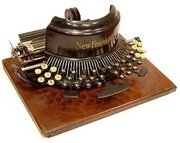
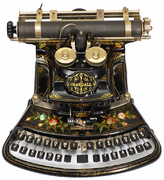 Beautiful Machine: 1886 Crandall Typewriter
Beautiful Machine: 1886 Crandall Typewriter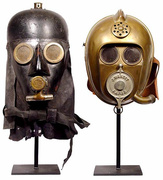
 Typewriter Collector Richard Polt on More Than a Century of QWERTY
Typewriter Collector Richard Polt on More Than a Century of QWERTY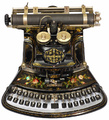 Beautiful Machine: 1886 Crandall Typewriter
Beautiful Machine: 1886 Crandall Typewriter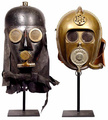 Before Steampunk: Star Wars’ 1800s Roots
Before Steampunk: Star Wars’ 1800s Roots TypewritersWhen you think about it, typing on a computer is a magical thing—just hit t…
TypewritersWhen you think about it, typing on a computer is a magical thing—just hit t… Mari Tepper: Laying it on the Line
Mari Tepper: Laying it on the Line Nice Ice: Valerie Hammond on the Genteel Charm of Vintage Canadian Costume Jewelry
Nice Ice: Valerie Hammond on the Genteel Charm of Vintage Canadian Costume Jewelry How Jim Heimann Got Crazy for California Architecture
How Jim Heimann Got Crazy for California Architecture Modernist Man: Jock Peters May Be the Most Influential Architect You've Never Heard Of
Modernist Man: Jock Peters May Be the Most Influential Architect You've Never Heard Of Meet Cute: Were Kokeshi Dolls the Models for Hello Kitty, Pokemon, and Be@rbrick?
Meet Cute: Were Kokeshi Dolls the Models for Hello Kitty, Pokemon, and Be@rbrick? When the King of Comedy Posters Set His Surreal Sights on the World of Rock 'n' Roll
When the King of Comedy Posters Set His Surreal Sights on the World of Rock 'n' Roll How One Artist Makes New Art From Old Coloring Books and Found Photos
How One Artist Makes New Art From Old Coloring Books and Found Photos Say Cheese! How Bad Photography Has Changed Our Definition of Good Pictures
Say Cheese! How Bad Photography Has Changed Our Definition of Good Pictures Middle Earthenware: One Family's Quest to Reclaim Its Place in British Pottery History
Middle Earthenware: One Family's Quest to Reclaim Its Place in British Pottery History Fancy Fowl: How an Evil Sea Captain and a Beloved Queen Made the World Crave KFC
Fancy Fowl: How an Evil Sea Captain and a Beloved Queen Made the World Crave KFC
I have a 1953 Royal Gold Deluxe typewriter that is exactly like the Ian Fleming model shown above that can be seen on this same website at:
http://www.collectorsweekly.com/stories/80687-royal-1953-gold-deluxe-portable
You can see more pictures of my typewriter and an article on it at:
http://spyvibe.blogspot.com/2013/04/ian-fleming-1953-royal-quiet-deluxe.html?m=1
hi, im just looking into type writers out of interest, im 15 but i have a deep appreciation for anything from the great war and earlier, i guess im a 1910’s kind of guy, im interested in seeing if there are any type writers made in australia around 1910 , preferably manual.
greetings and fairwells from australia
After graduating college, the entry level job for a woman was a secretary (yes it was the 70’s) . I had to go to Katherine Gibbs AFTER college to learn how to type. One of my first jobs was for SCM and wouldn’t you know, after 1 year I was fired because I had 2 mistakes on a letter I typed! Boy has life changed!
A quote from the article: “Seaver explains …“You had the office machines, which were really well-made, and of course, they were designed to last, because in the ’30s, firms weren’t going to be buying a new typewriter every year.” What would be THE best of those OFFICE TYPEWRITERS? I would greatly appreciate your thoughts. Thank you, Harvey
I remember the night Tom Hanks was on the Tonight Show and mentioned his Swiss Hermes 3000 because I have one too.
My home town had a typewriter seller and repair shop, but time caught up with it and they went out of business and sold the building which was torn down, but they had hundreds of typewriters and they just tossed them in the basement and they were covered over when they built the new building…..sometime in the future someone will dig that area up and find all these old typewriter’s and wonder what they are!!!
Our grandfather is 92 this month and still collects and repairs typewriters. He’s got nearly 500 machines. Some are junky, but some are gorgeous. We don’t know what we’ll do with them all.
Doesn’t the interest level (or lack of) indicate a much rarer experience and market for these awesome machines?
I have a 33 key Keaton music typewriter with original case and mounting board. There are many websites on this, including pictures, so I will not go into too much detail. Everywhere I read says it is very rare with only a dozen or so known to exist and most are in museums and with private collectors. I want to sell mine. In my research I saw one was for sale at Etsy for $6,000. It was sold but it does not say for how much. I need to come up with a price to put into an auction or sell myself. I appreciate any suggestions.
Thanks for the time, Anthony
I worked in the industry for nearly 30 years. The Hermes 3000 is the best manual typewriter. It’s well known for it’s smooth action and ease of use. I’ve worked on all the machines mentioned. Always found any Olivetti a pain to use and repair. I still have a few; Oliver 5 and 7, Remington with wooden keylevers, Blickensdorf. I daily use my trusty Olympia manual.
I have an Odell index machine by Farquart and Albrecht in the wooden box. All letters and numbers on 1 bar – slide the bar to the desired letter and push the 1 key. Any idea as to the rarity and value?
I have a Corona portable typewriter (still in its traveling case) from 1920’s according to the card with it. This was my great uncle’s typewriter, and he used it to type his comedy routines when he was in vaudeville. His name was Bill Bailey and our relatives have told the story over the years that the song “Won’t you come home Bill Bailey” was written after him. He used to perform on stage with a woman, and when he left her to be with my great aunt, she wrote the song. At every family reunion, we always sang the song! The typewriter still has the ink ribbon and still works. Any idea what it would be worth to a collector? Thank you.
Hello Tom , I have my grandmas type writer I never use it a Webster l -747 more than welcome to have it excellent condition and has the case . I live in central point Oregon Billie thrower
I have a typewriter that I am sure Tom has never seen in person. It is called the RIP5 made by Underwood. It was developed for use by the Japanese code breakers during WWII. A US radio intercept officer would copy a character in International Morse Code, for example an E as sent by a Japanese radio operator. When he pressed the E key on the typewriter keyboard, the corresponding Japanese Kona Code character was typed on the page. Once the message was typed, it was sent from the intercept operator to the code breakers with the corresponding Kona Code actually typed on the paper. I think that there may have been only 156 made, but could be wrong. I got mine in an antique store in Pearl Harbor. Does anyone know how much these are worth today???
I have a silver-reed 8650 typewriter in excellent condition . Can FedEx it to Mr. Tom Hanks, if he’s interested.
Hello Tom… I work for a non profit Bon Marche Thrift/Sonoma Vintage store’s in Sonoma, Ca. I had a customer donate a working portable “Remington 5” typewriter… I am sure that you already have this model in your amazing collection but wondered if you would like to purchase ours for your collection… I just love your typewriter story and how peaceful it makes you feel… I guess for me it would be personally handwritten things that bring me the same feeling… Thank you for sharing your story and taking the time. Hope to hear from you soon.
Caryn
I have a Manual Royal 470 which I do not want anymore. Would anyonelike to have it? It needs to be cleaned up (sticky keys). I will give it away. Thank you.
I have my grandfathers old typewriter he wrote sermons on. I have kept it for years hoping to see you one day and offer it to you. You are a wonderful actor, never any bad things posted about you. He passed away at 99 in 1974
Two “old” typewriters I have. One is a portable $ the other is a Corona, I think. I wish to donate them to a non profit. Two pictures can be sent upon your request. I want to help our society if they can be used.
#17 has a typewriter she would give away. I would be interested in taking it. If they still have it and want to get rid of it, let me know what do I need to do?
Good Morning Tom, I admire your collection and knowledge of typewriters. I have one you may want to add to your collection. It is a Hermes Rocket portable that I used in college in the early 1960s. It’s about 2″ high and has a light green hammer tone finished steel cover. It is rare and I would like to see it preserved in your collection.
i used in college. It’s about 2″ tall and has a light green hammer tone steel cover.
I have a Hermes Rocket portable I used in high school and college in the 60s. It’s about 2″ high and has a removable steel case. I would like it to find a home in Tom’s collection.
Dear Tom Hanks, my husband inherited his uncle’s portable Polish typewriter, which he would love to give away for free. If you’re interested, we could shipped it to your address. Hope to hear from you. We watch almost all your movies; you’re a great actor and amusing story teller on TV interviews. Agnes
I have had this typewriter for nearly 52 years!
it is a Gray Metal typewriter called,(i have the original brochure that came wit it!), S C M Smith-Corona STERLING and says bonus features in a world -famous portable…SCM Corporation.
has a trimline carrying case ..
For your info?
Helen Cooper & I am 91 years old & have used this typwriter for many years ago.
I have a 1953 Olympia typewriter that is virtually new. It has never been used. It has all manuals, original case, cover and the purchase receipt. It’s amazing!
I received an Olivetti Underwood script typewriter for a graduation present in 1964. It’s greenish in color, in it’s original case & wondered the value. Excellent condition.
Good day,
We recently got our hands on a Remington type writer, serial number Z114355 and I’m unsure of it’s worth but I must say it’s pretty and sets well in my house.
Blickensdorfer No 6. Have any of you heard that name. My first job in ‘72 was a commercial typewriter repairman. The Blickensdorger typewriter was made in Connecticut in the 1800’s. Predates the qwerty keyboard. Has a typeface cylinder predates IBM Selectrics. Unique.